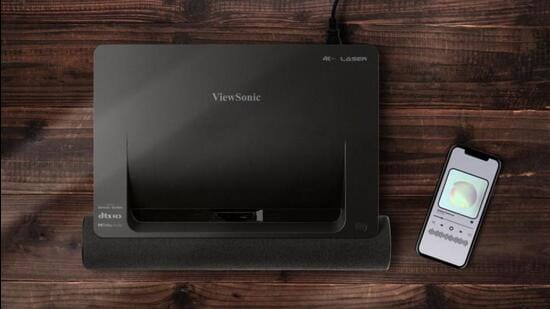There’s a concerted effort to iron out the complexities of home theatre projectors, with the hope they’d be simpler and fit better in most homes. It has worked, to a certain extent, with ultra-short-throw (or UST) projectors requiring much less space to work with. At the same time, if the ViewSonic X2000 is a harbinger for any sort of sustained trend, they’re becoming much smaller in size too. Ideal TV replacements, albeit belatedly? We may be getting there. A tricky balance is being achieved.
The argument for projectors, has been about how you get a much larger projection size for the money you spend. That is, compared with a TV that will remain the size you buy – 43-inches, 55-inches, 65-inches, for instance. The larger the projection size, potentially higher levels of immersion. The perception of more. Yet, projectors (at least till the UST became more common) required a lot of space and always had struggles with heat and dust. They seem less sensitive now.
The good ones still aren’t exactly inexpensive. The ViewSonic X2000 costs around ₹3,99,000 before you may be able to derive some value from the payment methods such as credit cards. What value you get from this, is perhaps best illustrated by the potential for a 100-inch projection size, when kept around 9-inches from a wall or projection screen. In essence, you can use the same table as your TV, for a much larger viewing experience (how large is your TV? 55-inches? 75-inches?).
Secondly, this projector has a much smaller footprint than most of its rivals, and siblings. The ViewSonic X1000 which we had reviewed some time ago, is much larger in size. That in theory means a slightly restricted laser at play (mostly in terms of supporting colour gamut) but does not compromise on HDMI connectivity as well as the quality of sound from the integrated soundbar.
It certainly helps that the ViewSonic X2000 delivers pleasing picture quality. Mind you, there will be a certain amount of effort that goes into tweaking the picture settings to get them right, but once you get past that curve, its plain sailing from then on. Colours are accurate and fairly vibrant, but this isn’t extreme saturation that some laser USTs have started delivering off late.
As is the standard rule with most TVs as well, you will need to try out the pre-set picture modes before eventually landing on the custom option to tweak it as you see fit. This projector has a 2000 lumens rating, which though very bright, is in a way a theoretical peak. The mode you select, along with colour temperature and active HDR, will determine how bright this can go.
You will find the “frame interpolation” option quite relevant – there are three levels (low, medium, and high). The idea being the projector will do its own layer of image processing to add a bit more detailing. For most content, including movies low or medium works best, depending on the quality of original content. A lot of the options available, in fact, attempt to replicate a TV-esque experience, including noise reduction and fast motion.
The soundbar that’s built in, has been tuned by Harman Kardon. For all that it is capable, this soundbar effectively eliminates the need for any additional speaker system to be put in place. That makes it versatile if you wish to move it around, and simpler to set up without a clutter to go alongside.
Something ViewSonic still needs to sort out, is the smart bit of the smart projector. That basically means the video streaming apps that can be accessed from the X2000 itself. The interface, how you’ll get to the apps and the streaming apps themselves, are a far cry from the premium experience that this projector otherwise ticks off effectively. It would be more prudent to connect a standalone streaming device, such as an Apple TV 4K or an Amazon Fire TV Stick 4K, for streaming access.
We are left with no doubt that the money you part with for the ViewSonic X2000, is an act that’s largely successful. The smaller footprint doesn’t really mean any compromise on the overall viewing and projection experience, and neither does it skimp on the width of capabilities. This uses the blue laser phosphor light source tech, and as per expectation, the default colour temperature leans slightly towards the cooler side. It also cannot do the complete DCI-P3 colour gamut range, but then again, you may not find a lot missing for a home theatre projector.
The fact that the ViewSonic X2000 is bright enough for use in a room with a lot of ambient light streaming in, simply adds to the versatility and convenience. You surely pay a lot over even the largest of OLED TVs in the market (those would be the 65-inch or 75-inch options), but that’s where the projector goes even larger in projection size. For a movie, a live cricket match or simply a lazy binge session on the weekend, that larger canvas is worth the money spent.

